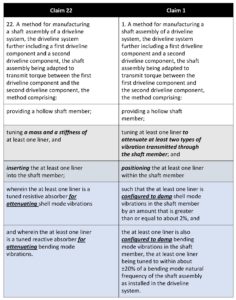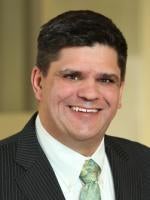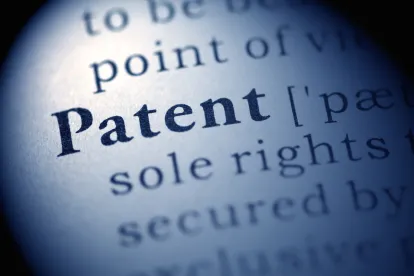On July 31, 2020, the U.S. Court of Appeals for the Federal Circuit issued a modified and reissued decision[1] (American Axle II) of its earlier October 3, 2019 decision[2] (American Axle I) in response to a combined petition for panel rehearing and hearing en banc concerning patent eligibility under 35 U.S.C. § 101. At issue were independent claims 1 and 22 and associated asserted dependent claims of U.S. Patent No. 7,774,911 entitled “Method for Attenuating Driveline Vibrations.” In the July 31, 2020 modified decision, the majority opinion maintained that claim 22 was patent-ineligible, but changed its original opinion affirming the patent ineligibility of claim 1 and, instead, remanded claim 1 to the district court for further proceedings. Both decisions were split, over strongly worded dissents. There were several additional vigorous dissents in a 6-6 decision[3] denying the petition for rehearing en banc.
In this article, we reconcile the different findings for the two claims, using earlier Supreme Court precedent which is factually closer than decisions of the last decade. While some commentators have expressed concern and confusion over the holdings in American Axle I and American Axle II, we propose that the majority’s opinion in American Axle II can be explained in a more straightforward manner.
U.S. Patent No. 7,774,911
The technology at issue in U.S. Patent No. 7,774,911 (’911 Patent) relates to propeller shafts that transmit rotary power in a driveline. Such shafts typically are made of relatively thin-walled metal, making the shafts susceptible to three different vibration modes: bending mode, torsion mode, and shell mode. Each mode corresponds to a different vibration frequency.
One approach to reducing or attenuating vibration involves the use of a liner inside the propeller shaft. The liner also vibrates. Depending on the liner’s vibration frequency, the liner may reduce vibration in a propeller shaft assembly. Previously, these liners would attenuate one of the three vibration modes. The ’911 Patent describes a shaft assembly manufacturing method using a liner that results in attenuation of two of the three modes, specifically, bending mode and shell mode.
The issue faced by the Federal Circuit was whether the claimed methods were patent-ineligible under 35 USC § 101 for impermissibly claiming a law of nature, in this case Hooke’s Law — “an equation that describes the relationship between an object’s mass, its stiffness, and the frequency at which the object vibrates”[4] — and whether the claimed methods include an “inventive concept” that transforms the claims “into patent eligible matter” as required under the second step of the Mayo/Alice analysis. [5]
The majority opinion in American Axle II held that one of the claims (claim 22) required tuning only the mass and stiffness of the liner, and so claimed Hooke’s Law as a law of nature. In contrast, the majority found, without much discussion, that the other claim (claim 1), which arguably claimed tuning more broadly as an abstract idea, needed to be explored in more detail below; hence the remand.
A Tale of Two Claims – Tuning in to Mass and Stiffness
In both American Axle I and American Axle II, the majority focused on two independent claims, claim 1 and claim 22. It is helpful to look at the claims side by side (emphasis added):

As seen in this chart, both claims recite identical preambles: “[a] method for manufacturing a shaft assembly of a driveline system”.
With respect to claim 22, focusing almost exclusively on the recitation of “tuning a mass and a stiffness of at least one liner,” the majority found that the explicit reference to mass and stiffness was directed to Hooke’s Law. The court noted that both parties accepted the trial court’s construction of the term, “controlling the mass and stiffness of at least one liner to configure the liner to match the relevant frequency or frequencies”.[6]
In supporting its decision, the majority analogized claim 22 more closely to the situation in Parker v. Flook[7] and differentiated it from the one in Diamond v. Diehr.[8][9] Flook involved claims directed to calculating and updating an alarm limit. The claims, however, did not recite any actions being done in response to the alarm limit calculation or updating. In contrast, Diehr’s claim used a mold temperature calculation in a process to cure rubber. The claim in Diehr was found patent eligible under §101 whereas those in Flook claim were not. Claim 22 met a similar fate here in American Axle I and II. Despite the recitation of “inserting the at least one liner into the shaft member” – an apparently physical step – the majority held that the claim failed to recite an inventive concept, because the recited results were merely desired results, and did not constitute an “advance”.[10]
The majority’s discussion of claim 1 in American Axle II is quite brief and rather superficial, citing no case law. In the original American Axle I, the court treated claim 1 and claim 22 the same way, analogizing both to the claim in Flook and finding them both ineligible. In American Axle II, the court began its discussion by saying, “While it is true that both claims require ‘tuning,’ claim 1 is more general.”[11] The majority cited the district court’s construction of claim 1’s “tuning at least one liner to attenuate at least two types of vibration transmitted through the shaft member”: “controlling characteristics of at least one liner to configure the liner to match a relevant frequency or frequencies to reduce at least two types of vibration transmitted through the shaft member” (emphasis added).[12]
Because the majority agreed with the assertion that the patent specification described additional “characteristics” besides mass or stiffness,[13] it therefore viewed claim 1 as “more general” and not solely “directed to” Hooke’s Law. This view does not seem particularly helpful, because the district’s court’s construction of the claim language reads on “mass and stiffness,” which the court already found was “directed to” Hooke’s Law.
The majority noted that “[t]he district court’s opinion suggested that the broader concept of tuning [in claim 1] is an abstract idea”.[14] Finding that “the abstract idea basis was not adequately presented and litigated in the district court,”[15] the Federal Circuit vacated the judgment finding claim 1 patent ineligible under § 101 and remanded to the district court to address this issue.
Nothing Runs Like a Diehr
At first glance, finding claim 22 patent ineligible and vacating as to claim 1 seems inconsistent. The language of the claims is similar and the claim 1 “tuning” language would appear to encompass the “mass and stiffness” language of claim 22.
Comparing only the “tuning” language in both claims would seem to point to finding claim 1 patent-ineligible for the same reason as claim 22. The majority did not indicate clearly that claim 1 was patent-eligible, but on remand, the district court may maintain its position that claim 1 is not patent-eligible and directed to an abstract idea.
We see other language in claim 1, however, that may support patent eligibility as an inventive concept under the Mayo/Alice analysis. The majority made a passing statement about claim 1’s recitation of “positioning the at least one liner.”[16] Claim 22 recites “inserting the at least one liner,” but the majority did not compare or contrast “positioning” in claim 1 with “inserting” in claim 22.
The “positioning” step of claim 1 recites “configur[ing]” the liner to damp both shell mode vibrations and bending mode vibrations. This “configur[ing]” language is more similar to the patent-eligible language in Diehr (reciting curing of rubber) than to the patent-ineligible language in Flook (reciting updating an alarm value). Although the Federal Circuit did not compare claim 1 to either Flook or Diehr, it is possible to see that claim 1 looks more like the patent-eligible claim in Diehr, had the majority made such a comparison.
Given the lack of case law in the majority’s discussion of claim 1, it is difficult to predict what case law the district court might apply in determining the patent eligibility of claim 1 on remand. In the wake of Mayo[17] and Alice,[18] it is entirely possible that the district court may overlook the earlier Supreme Court precedent articulated in Diehr which is analogous to the situation found in claim 1.
Takeaways
Having physical elements in a claim will not save the claim from patent-ineligibility if there are one or more “natural law” elements that do not tie sufficiently to those physical elements. Claiming a physical result of using a “natural law” also may not save a claim from patent ineligibility. When drafting claims that recite a calculation, practitioners should make sure there is at least one claim element that does something useful with the calculation.
[1] American Axle & Manufacturing, Inc. v. Neapco Holdings LLC, Neapco Drivelines LLC (Fed. Cir., July 31, 2020) (American Axle II).
[2] American Axle & Manufacturing, Inc. v. Neapco Holdings LLC, Neapco Drivelines LLC (Fed. Cir., October 3, 2019) (American Axle I).
[3] American Axle & Manufacturing, Inc. v. Neapco Holdings LLC, Neapco Drivelines LLC denial of Petition for rehearing en banc (Fed. Cir., July 31, 2020).
[4] American Axle II at 7.
[5] Id. at 21.
[6] Id. at 6.
[7] 437 U.S. 584 (1978).
[8] 450 U.S. 175 (1981).
[9] American Axle II at 19-21.
[10] Id. at 21.
[11] Id. at 24.
[12] Id.
[13] Id. at 24-25.
[14] Id. at 25.
[15] Id. at 25-26.
[16] Id. at 25.
[17] Mayo Collaborative Services v. Prometheus Laboratories, Inc. 566 U.S. 66 (2012).
[18] Alice Corp. v. CLS Bank Int’l, 573 U.S. 208 (2014).





 />i
/>i
